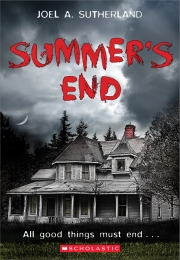| ________________
CM . . .
. Volume XXIII Number 36. . . .May 26, 2017

 |
Summer’s End.
Joel A. Sutherland.
Toronto, ON: Scholastic Canada, 2017.
261 pp., trade pbk. & html, $7.99 (pbk.).
ISBN 978-1-4431-3931-1 (bk.), ISBN 978-1-4431-3932-8 (html).
Grades 6-8 / Ages 11-13.
Review by Charlotte Duggan.
*** /4
|
| |
|

excerpt:
“He-hello?” Jacob called out. He hoped Ichiro wouldn’t give him a hard time later about his voice cracking. “Is anyone here?”
No one answered.
Dust painted every surface. Tangled strands of cobwebs clung to the ceiling. A long, narrow hallway was dissected by four closed doors, concealing whatever lay in wait behind them.
Jacob began to picture an assortment of horrors hiding behind each of the doors. He’d watched too many horror movies, read too many Stephen King books, and his imagination was making things worse than they were. This was just an old house that hadn’t been lived in for years. Nothing else.
“All right,” he said, “I’ve seen enough for now. We can go.”
Young teens looking for a dish of classic suspense and horror will be well satisfied with Summer’s End by Ontario author Joel Sutherland. Sutherland has made a career of writing entertaining YA novels, and Summer’s End is no exception. In this well-paced tale, Sutherland serves up all our favourite horror tropes of mains and sides with expertise and relish.
The story follows the summer adventures of four teens planning an epic last summer together before their varied high school plans separate them forever. Most of the action follows the sensitive and somewhat prescient Jacob. He is the most affected by the foursome’s pending separation, and it is Jacob’s tender psyche that becomes entwined with the spooky mystery.
While exploring the Muskoka lake system in Ichiro’s new canoe, Jacob and Ichiro come upon an abandoned Victorian mansion called Summer’s End, the only building on a hidden island. “I have a strange feeling about this place,” Jacob says to Ichiro, both foreshadowing and understating the nightmare Summer’s End will become for the boys and their friends by the end of summer.
Sutherland isn’t shy about laying out all the classic haunted house elements. As the boys tiptoe about the abandoned mansion for the first time, they encounter dusty antique furniture, cobwebs, and strange creepy sayings that have been framed and put on display. And as the first exploration of the old house ramps up, they hear a lullaby from an old phonograph, running feet behind walls and, most chilling of all, a bone-chilling screaming that drives the boys out of the house.
Like all good horror stories, plot and setting are deeply connected here. With the help of the local librarian – hard not to like a plotline that includes research at the local library - the boys learn that the abandoned mansion was once the home of the Stockwell Family. In the early 1900s, Dr. Stockwell and his new bride opened their home to convalescing TB patients. A personal tragedy triggers a mental collapse in Dr. Stockwell, and murder and mayhem soon follow.
It takes the boys several trips to the library and plenty of intuition on Jacob’s part to piece the complex story together. Sutherland deftly drops lots of clues that clever readers will enjoy tracking right along with Jacob and his friends, including a journal, photographs and letters. Very engaged readers may note, for example, the telling reoccurrence of the colour red - from the eerie opening scene where the four friends find a dying red cardinal, to the mysterious sightings of a boy with a red hat, to the bloody horror of the cellar in Summer’s End.
The mansion has a strange pull on the boys, in particular on Jacob. He is simultaneously terrified and obsessed with it. The mystery enters his subconscious, and he dreams about it. It stimulates a recollection of a shameful repressed memory about a local boy who is presumed drowned in the lake. Jacob determines to right a wrong he feels he’s committed.
The dynamic of this friend group may remind readers of films like Stand By Me and Goonies. They are a supportive, likeable group of kids, and while not wholly fleshed out like Jacob, the supporting cast of teens consists mostly of unique individuals with interesting personalities. In particular, most readers will appreciate the energy and perspective that Hannah adds.
Jacob’s hard working single mom might fit the too-good-to-be-true category. Still, she provides a sounding board for Jacob’s worries about the future and a way for the reader to gauge Jacob’s growing independence. Jacob’s positive open relationship with his mother might also be the reason Jacob has the confidence to approach Mrs. Cannington whose dead son holds the key to the novel’s mystery.
It is, of course, a dark and stormy night when the four teens set out to finally solve the mystery of Summer’s End, and the climax of the story is just as breath-takingingly scary as it should be. Summer’s End is a good, fun addition to the young adult horror fiction section of a middle school classroom or library.
Recommended.
Charlotte Duggan is a teacher-librarian in Winnipeg, MB.

To comment
on this title or this review, send mail to cm@umanitoba.ca.
Copyright © the Manitoba Library Association. Reproduction for personal
use is permitted only if this copyright notice is maintained. Any
other reproduction is prohibited without permission.
Next Review | Table of Contents For This Issue - May 26, 2017
CM Home | Back Issues
| Search
| CM Archive
| Profiles Archive
|
